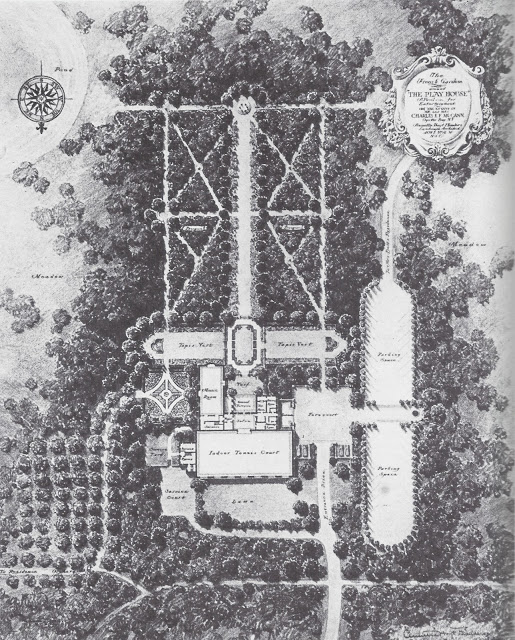History of The sunken orchard name
The original house was designed in 1914 by George B. de Gersdorff for Mr. & Mrs. Fay Ingalls, who called their property “Sunken Orchard”. The original landscaping and gardens were designed by the landscaping architect duo of Innocenti and Webel. In 1925 Mr. and Mrs. Charles McCann purchased the estate and hired Architect James W. O'Connor to make alterations to the house, as well as add on a plethora of gardens and design a separate playhouse with indoor tennis court. Annette Hoyt Flanders received the Gold Medal of the Architectural League of New York for her work on the French garden surrounding the playhouse. The McCann’s retained the name "Sunken Orchard".
Map of Playhouse and Gardens expansion
The Sunken Orchard
In 1938 Mrs. McCann passed away, followed by her husband Charles 3 years later in 1941. Constance McCann McMullan, now remarried, was left as the executor of the estate, she keeps a bulk of the estate intact at first including the playhouse, main residence, and her own house. By 1949 the estate was becoming more cumbersome and expensive to maintain. Constance McMullen, hires Frank Vergata (Sunken Orchard Ceramics founder Raffaela Vergata’s grandfather) as her estate superintendent to begin cleaning up and restoring some of the grounds in preparation to sell. The Vergata’s move into a caretakers cottage off of what is now Sunken Orchard Lane.
Looking at Playhouse from French Gardens
William "Billy" Woodward Jr. (June 12, 1920 – October 31, 1955) was the heir to the Hanover National Bank fortune (later Manufacturer's Hanover), the Belair Estate and stud farm and legacy, and a leading figure in racing circles before he was shot to death by his wife, Ann Woodward, in what Life magazine called the "Shooting of the Century".
In the mid 70’s Constance and Joe McMullen still had Frank Vergata employed as their superintendent and estate caretaker. As they were getting older they wanted Frank to be closer and so sold him him a 2.6 acre plot of land along their driveway from 25A, what will become Grace Lane. He builds a caretakers cottage up on this hill which is now the current home of Sunken Orchard Ceramics.
Frank Vergata, the last superintendent on Sunken Orchard Estate, was asked by Constance McCann to build a house at the top of the hill overlooking the drive up to the main house. This is where our studio and home lies today, in the same structure build by Raffaela’s grandfather.
McCann residence 1936
Playhouse Entrance and Parking Lot - The cobblestones were all brought from France
Another View of the Sunken Orchard
Vista from Playhouse towards Temple
Around 1950, Constance rents the Playhouse living quarters to Mr. & Mrs. William Woodward Jr., who were looking for a weekend getaway outside New York City. At the same time, Constance rented the indoor tennis court and lower area of the Playhouse to Cinerama Film Productions. The world renowned movie picture technology was developed and distributed in this space for the next decade before moving to California.
In 1953 Mr. Woodward Sr. passes away and William inherits all of his fathers fortune, including the 2000 acre Belair Estate and stud farm. Constance offers to sell the remainder of the Sunken Orchard estate to the Woodward’s and they turn it down. Instead they buy only the residential side of the Playhouse and approximately 25 acres including what had been the main entrance to the estate, now renamed Woodward drive it would only be used for the Playhouse.
From here on, the main house (still owned by the McCann estate) would use what is currently Sunken Orchard Lane for access. In 1954 William and Dorthy Long purchased what was left of Sunken Orchard. Much of the estate had already been rented, and then sold by Constance throughout the early 50’s and broken or developed into smaller plots. In 1985 Mr. Long died at Sunken Orchard at the age of 92. The remainder of the estate was sold to a developer and broken into smaller plots, the final end of a beautiful dream.
The indoor Tennis court which would become the founding location of the Cinerama Film Company.
Back of residence with stepped turf panels
Mr. McCann was a lawyer and a partner in the brokerage firm of Douglas, Armitage & McCann. Mrs. McCann, the former Helena Woolworth, reportedly spent $3.5 million for "Sunken Orchard" and subsequent architectural improvements including the twelve gardens designed by Flanders. During the McCann ownership "Sunken Orchard" grew to more than 192 acres. Outside the French gardens was a path flanked by perennial beds, another large perennial garden, a house terrace, a swimming pool next to the outdoor tennis court, and a boxwood garden. The grounds included a woodland carpeted with wild flowers, a pond bordered with iris and azaleas, the sunken orchard (the namesake of the estate) was planted with a carpet of violets, a bridle path, a pond made in the woodland, and a dogwoods surrounding the outdoor tennis court.
In the early 1930 the McCann’s held lavish parties, weddings, celebrations and events that were prestigious and affluent to the point where they were announced and reported on in the New York Times. The McCann’s built another house for their daughter Constance when she was married to her first husband Betts. Her sister Helena would also be married at Sunken Orchard in the mid 30’s and she would also be given a piece of property next to the estate.
Playhouse Terrace overlooking the French Gardens
Walking path outside the french gardens
There were many fountains, gardens, and trellis’ throughout the estate
Woodland path from Residence to Playhouse















